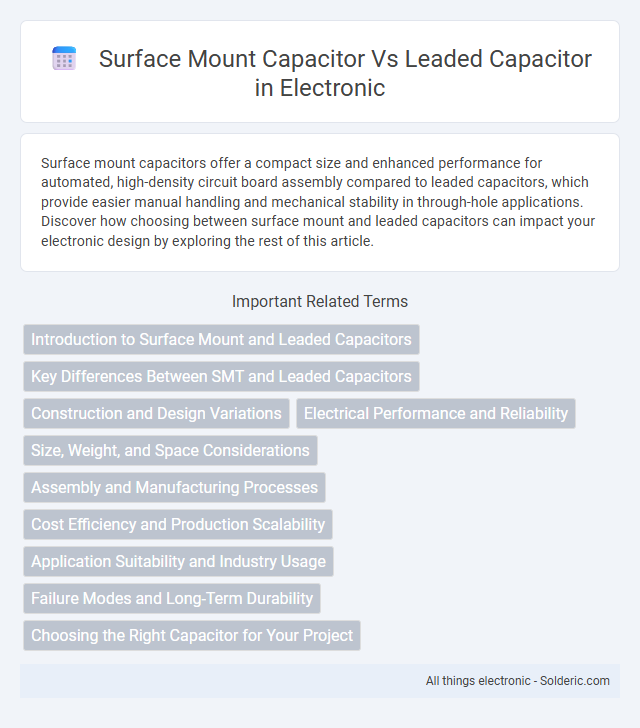Surface mount capacitors offer a compact size and enhanced performance for automated, high-density circuit board assembly compared to leaded capacitors, which provide easier manual handling and mechanical stability in through-hole applications. Discover how choosing between surface mount and leaded capacitors can impact your electronic design by exploring the rest of this article.
Comparison Table
| Feature | Surface Mount Capacitor (SMD) | Leaded Capacitor |
|---|---|---|
| Mounting Type | Surface mount on PCB pads | Through-hole leads inserted into PCB |
| Size | Smaller, compact footprint | Larger, bulkier |
| Assembly | Automated pick-and-place machines | Manual or wave soldering |
| Frequency Performance | Better high-frequency characteristics | Lower frequency limit, more parasitic inductance |
| Mechanical Stress | Less stress due to no leads | Lead bending possible; better shock resistance |
| Cost | Typically lower in high volume | Higher due to manual labor |
| Repair & Replacement | Challenging to rework | Easier to replace and test |
| Applications | Modern electronics, compact devices | Prototyping, high power, or mechanical durability |
Introduction to Surface Mount and Leaded Capacitors
Surface mount capacitors (SMCs) and leaded capacitors differ primarily in packaging and mounting techniques, with SMCs being designed for automated placement on printed circuit boards (PCBs) and leaded capacitors featuring wire leads for through-hole insertion. SMCs offer reduced size and parasitic inductance, enhancing high-frequency performance and enabling miniaturization in modern electronics. Leaded capacitors provide mechanical stability and ease of prototyping, often preferred in applications requiring higher voltage ratings and simpler assembly processes.
Key Differences Between SMT and Leaded Capacitors
Surface mount capacitors (SMT) are designed for automated assembly with a compact, flat package suitable for high-density circuit boards, whereas leaded capacitors feature wire leads for through-hole mounting, providing mechanical stability and easier manual replacement. SMT capacitors typically offer lower parasitic inductance and better high-frequency performance, while leaded capacitors excel in handling higher voltages and currents with improved thermal dissipation. The choice between SMT and leaded capacitors depends on the application's size constraints, performance requirements, and assembly methods.
Construction and Design Variations
Surface mount capacitors (SMCs) feature a compact, rectangular ceramic or tantalum body with metalized electrodes on the ends, designed for automatic PCB placement, minimizing inductance and resistance. Leaded capacitors, typically consisting of larger radial or axial bodies with wire leads, offer ease of prototyping and manual insertion but have higher parasitic inductance due to their lead length. Differences in dielectric materials and packaging result in distinct electrical characteristics, with SMCs optimized for high-frequency, space-constrained applications while leaded types suit lower-frequency or high-voltage needs.
Electrical Performance and Reliability
Surface mount capacitors offer superior electrical performance due to lower parasitic inductance and resistance, enhancing high-frequency response and signal integrity compared to leaded capacitors. Their compact size and automated assembly processes increase manufacturing consistency and reduce defects, leading to improved reliability in demanding applications. Leaded capacitors, while easier to handle and replace, typically exhibit higher parasitic effects, making them less optimal for high-speed or high-precision circuits.
Size, Weight, and Space Considerations
Surface mount capacitors are significantly smaller and lighter than leaded capacitors, making them ideal for compact electronic devices where space is limited. Their minimal footprint allows for higher component density on printed circuit boards, optimizing your device's overall size and design efficiency. Leaded capacitors, being larger and heavier, are better suited for applications where durability and ease of manual installation are priorities.
Assembly and Manufacturing Processes
Surface mount capacitors enable automated assembly through pick-and-place machines, significantly increasing manufacturing speed and consistency compared to leaded capacitors, which typically require manual or wave soldering methods. The compact size and flat terminals of surface mount capacitors facilitate precise placement on printed circuit boards (PCBs), reducing assembly time and minimizing human error. For your production line, choosing surface mount technology can streamline manufacturing workflows and improve overall product reliability.
Cost Efficiency and Production Scalability
Surface mount capacitors (SMCs) offer significant cost efficiency by enabling automated placement with high precision and speed, reducing labor costs and minimizing material waste compared to leaded capacitors. SMCs support superior production scalability due to their compatibility with advanced pick-and-place machines and streamlined assembly processes, facilitating mass production with consistent quality. In contrast, leaded capacitors require more manual handling, increasing production time and expenses, making them less ideal for large-scale manufacturing.
Application Suitability and Industry Usage
Surface mount capacitors excel in high-density circuit boards and automated manufacturing environments, making them ideal for consumer electronics, telecommunications, and automotive industries. Leaded capacitors, with their robust mechanical strength and ease of manual soldering, remain preferred in aerospace, military, and power electronics where durability and reliability under extreme conditions are critical. The choice between surface mount and leaded capacitors is driven by application-specific requirements such as space constraints, vibration resistance, and assembly processes.
Failure Modes and Long-Term Durability
Surface mount capacitors typically exhibit fewer failure modes related to mechanical stress due to their smaller size and lack of leads, reducing susceptibility to solder joint cracking and vibration-induced damage compared to leaded capacitors. However, surface mount capacitors can be more prone to thermal stress and delamination during reflow soldering processes, potentially affecting long-term reliability. Leaded capacitors generally offer better strain relief from mechanical stresses but may suffer from lead oxidation and corrosion over time, impacting their durability in harsh environments.
Choosing the Right Capacitor for Your Project
Surface mount capacitors offer compact size and higher-frequency performance, making them ideal for modern, densely packed circuit boards. Leaded capacitors provide easier manual handling and robust mechanical stability, suitable for prototyping or high-power applications. Your choice depends on project requirements such as space constraints, assembly methods, and electrical performance criteria.
surface mount capacitor vs leaded capacitor Infographic

 solderic.com
solderic.com